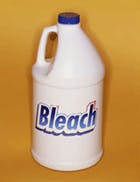Georgetown, Ky., Municipal Water and Sewer Service (GMWSS) has developed a new technology for water treatment that removes dangerous chlorine gas tanks from their wastewater treatment plant site and replaces them with everyday, grocery-store alternatives. GMWSS water treatment supervisor Jim Long said of the tanks, “These loose cylinders will soon be a thing of the past.”
Long realized that the chlorine tanks themselves, coupled with the location of the plant, were a hazard as he conducted the plant’s vulnerability assessment following the Sept. 11, 2001, attacks.
“The prevailing wind here is from the west," he said, "right toward the center of town. If anything happened to one of these tanks, there would have to be an evacuation in a two-mile radius in the daytime and a five-mile radius at night."
Luckily, the gas will no longer be a problem, as the plant will now be using liquid bleach manufactured on site to purify its water. Manufacturing the bleach requires food-grade salt, which is mixed with water to form a brine.
"It goes from a solid to a liquid, and then it goes through electrolysis," Long said. "The electric current goes through it and converts it into bleach."
After the bleach disinfects the water, it is pumped into a well and then to a storage tank. From there, the water receives ultraviolet treatment before being sent to customers. The UV treatment makes up step two of the three-step plant improvements.
Step three was to build a dome over the clarifier. The dome was created to protect the water from terrorist attacks and preventing algae build-up.
Overall, Billy Jenkins, GMWSS general manager, credits the project with a number of improvements.
"We did maintenance, we made some replacements and we added new technology," he said. "And we were only down 30 days. The construction company, Herrick of Lawrenceburg, did a great job to keep up with the pace. We gave them a 30-day window to get the project done, and they were down here working seven days a week."
Long agrees that the project, despite its $1.3 million cost, was worth the expense.
"We will recoup our costs as we go along," he said, "but it's cheaper than body bags. We took a time bomb out of here."
Source: Georgetown News-Graphic; Georgetown, Ky.


